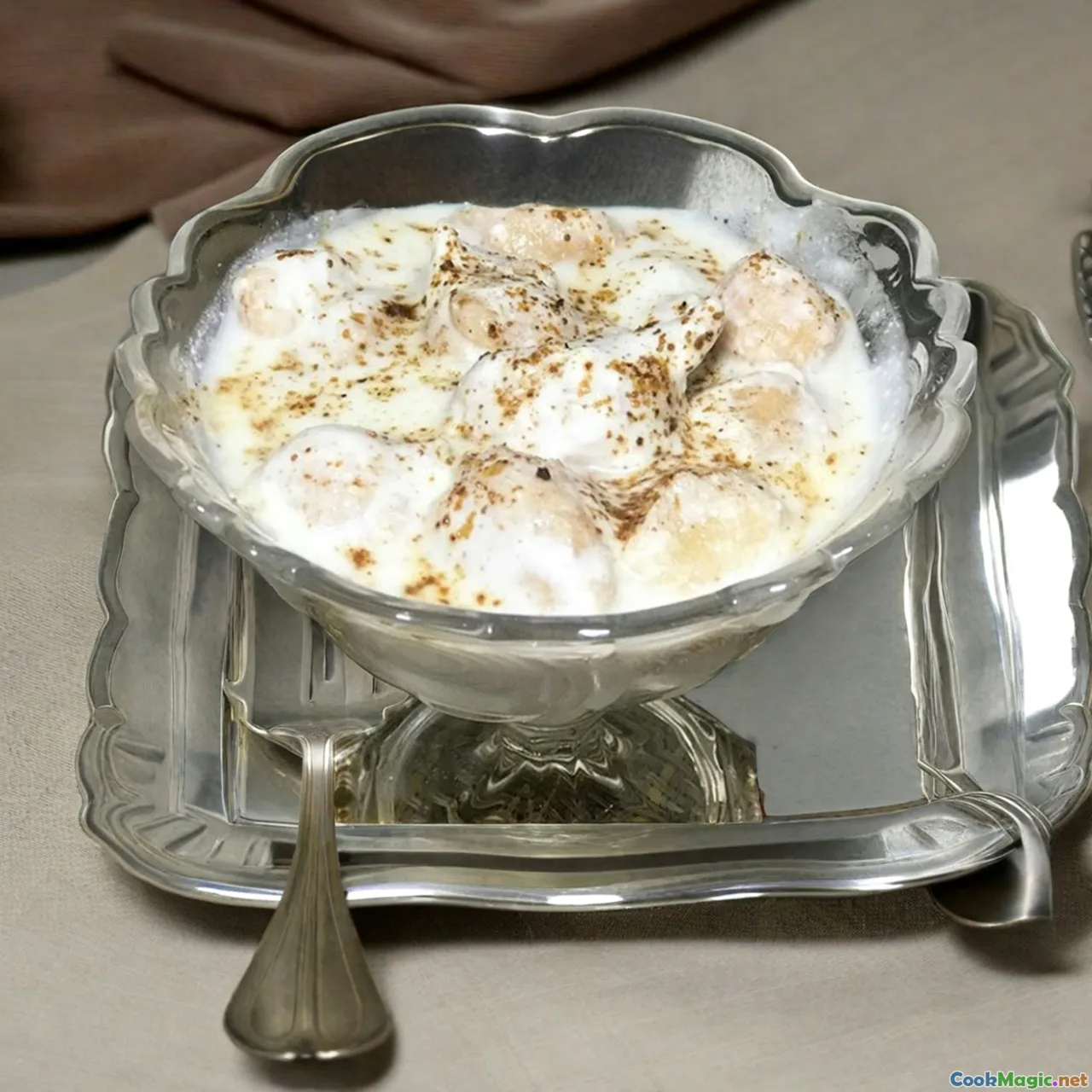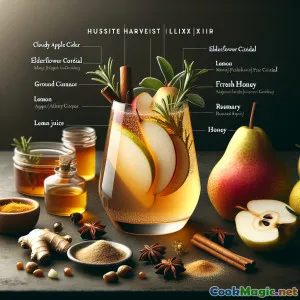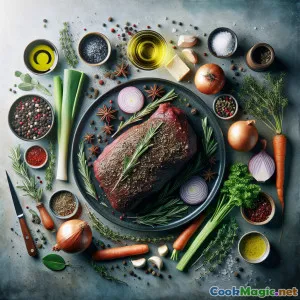
Kufle z kremem z soku brzozowego i jęczmienia: Angielska rozkosz
(Birch Sap & Barley Cream Pots: An English Delight)
(0 Recenzje)0
1,208
lipiec 14, 2025
Zgłoś problem
Składniki
-
60 grams Jęczmień perłowy
(Opłukane pod zimną wodą)
-
300 ml Mleko pełnotłuste
(Gotowanie jęczmienia)
-
200 ml Sok z brzozy
(Świeży lub butelkowany; można go zastąpić wodą kokosową o łagodniejszym smaku)
-
250 ml Podwójna śmietanka
(Dla bogactwa i gładkiej tekstury)
-
60 grams Cukier puder
(Dostosuj do smaku w zależności od słodyczy soku z brzozy)
-
3 large Żółtka jaj
(W temperaturze pokojowej)
-
1 whole Laska waniliowa
(Przekrój i wydrap ziarna, lub użyj 1 łyżeczki pasty waniliowej)
-
1/4 tsp Sól morska
(Wzmacnia smak)
-
2 tsp Miód
(Dzika angielska kwitnąca roślina, do polewania)
-
20 grams Prażone orzechy laskowe
(Grubo posiekane, do dekoracji)
(Opłukane pod zimną wodą)
(Gotowanie jęczmienia)
(Świeży lub butelkowany; można go zastąpić wodą kokosową o łagodniejszym smaku)
(Dla bogactwa i gładkiej tekstury)
(Dostosuj do smaku w zależności od słodyczy soku z brzozy)
(W temperaturze pokojowej)
(Przekrój i wydrap ziarna, lub użyj 1 łyżeczki pasty waniliowej)
(Wzmacnia smak)
(Dzika angielska kwitnąca roślina, do polewania)
(Grubo posiekane, do dekoracji)
Wartości odżywcze
- Porcje: 4
- Wielkość porcji: 1 ramekin (150ml)
- Calories: 350 kcal
- Carbohydrates: 33 g
- Protein: 7 g
- Fat: 21 g
- Fiber: 2.5 g
- Sugar: 13 g
- Sodium: 70 mg
- Cholesterol: 134 mg
- Calcium: 115 mg
- Iron: 1.2 mg
Instrukcje
-
1 - Gotuj jęczmień z mlekiem:
Opłucz perlę jęczmienną i dodaj ją do małego garnka z pełnym mlekiem. Doprowadź do delikatnego wrzenia i gotuj, bez przykrycia, aż jęczmień będzie bardzo miękki, około 25 minut. Regularnie mieszaj, aby nie przywarło. Odstaw i lekko ostudź.
-
2 - Miksuj dla kremowości:
Wlej ugotowaną jęczmień i pozostałe mleko do blendera. Zmiksuj dokładnie, aż mikstura będzie jak najbardziej gładka. Przepuść przez drobne sito, aby usunąć pozostałe łuski jęczmienia i uzyskać bardziej jedwabistą teksturę.
-
3 - Naparzanie soku z brzozy i śmietany:
W czystym rondlu połącz sok z brzozy, podwójną śmietanę, odfiltrowaną mieszankę jęczmienia oraz nasiona laski waniliowej (jeśli używasz). Delikatnie podgrzewaj, ciągle mieszając, aż zacznie się parować, ale nie zagotuj.
-
4 - Przygotuj żółtka jaj i cukier:
W międzyczasie, ubij żółtka jajek z cukrem pudrem i solą morską w dużej misce, aż będą jaśniejsze i lekko zagęszczone.
-
5 - Przyprawić i połączyć:
Powoli wlewaj około jednej trzeciej gorącego kremu z brzozy i jęczmienia do mieszanki jajek, cały czas energicznie mieszając. Gdy masa się zahartuje, wlej ją z powrotem do rondla z resztą gorącego płynu, cały czas mieszając.
-
6 - Gotowanie bazy budyniowej:
Na małym ogniu, cały czas mieszaj masę budyniową, aż zgęstnieje na tyle, żeby pokryć szpatułkę (około 82°C, jeśli używasz termometru). Nie dopuszczaj do wrzenia.
-
7 - Chłodzenie w ramekinach:
Podziel na cztery ramekiny po 150 ml. Pozwól ostygnąć do temperatury pokojowej, następnie przykryj i schłodź w lodówce przez co najmniej 2 godziny, aż lekko stwardnieje.
-
8 - Dekoracja i podanie:
Do podania polej odrobiną angielskiego miodu na wierzch i posyp posiekanymi prażonymi orzechami laskowymi, jeśli chcesz. Podawaj na zimno i kremowo.
Opłucz perlę jęczmienną i dodaj ją do małego garnka z pełnym mlekiem. Doprowadź do delikatnego wrzenia i gotuj, bez przykrycia, aż jęczmień będzie bardzo miękki, około 25 minut. Regularnie mieszaj, aby nie przywarło. Odstaw i lekko ostudź.
Wlej ugotowaną jęczmień i pozostałe mleko do blendera. Zmiksuj dokładnie, aż mikstura będzie jak najbardziej gładka. Przepuść przez drobne sito, aby usunąć pozostałe łuski jęczmienia i uzyskać bardziej jedwabistą teksturę.
W czystym rondlu połącz sok z brzozy, podwójną śmietanę, odfiltrowaną mieszankę jęczmienia oraz nasiona laski waniliowej (jeśli używasz). Delikatnie podgrzewaj, ciągle mieszając, aż zacznie się parować, ale nie zagotuj.
W międzyczasie, ubij żółtka jajek z cukrem pudrem i solą morską w dużej misce, aż będą jaśniejsze i lekko zagęszczone.
Powoli wlewaj około jednej trzeciej gorącego kremu z brzozy i jęczmienia do mieszanki jajek, cały czas energicznie mieszając. Gdy masa się zahartuje, wlej ją z powrotem do rondla z resztą gorącego płynu, cały czas mieszając.
Na małym ogniu, cały czas mieszaj masę budyniową, aż zgęstnieje na tyle, żeby pokryć szpatułkę (około 82°C, jeśli używasz termometru). Nie dopuszczaj do wrzenia.
Podziel na cztery ramekiny po 150 ml. Pozwól ostygnąć do temperatury pokojowej, następnie przykryj i schłodź w lodówce przez co najmniej 2 godziny, aż lekko stwardnieje.
Do podania polej odrobiną angielskiego miodu na wierzch i posyp posiekanymi prażonymi orzechami laskowymi, jeśli chcesz. Podawaj na zimno i kremowo.
Więcej o: Kufle z kremem z soku brzozowego i jęczmienia: Angielska rozkosz
Birch Sap and Barley Cream Pots
Summary
This wholly original recipe for Birch Sap and Barley Cream Pots captures the gentle awakening of an English spring in a delicate, creamy dessert bowl. Combining the subtle, natural sweetness of birch sap with the nutty, old-world flavors of barley, and elevating it all with rich dairy and softly set custard, this dish blurs the lines between modern British innovation and age-old traditions. Its unassuming, creamy aesthetics hint at something more interesting upon first spoonful—an earthy complexity and layers of silky, gentle sweetness.
History and Cultural Significance
Birch sap, gathered from centuries-old woodland traditions, was once a celebrated ingredient in the Northern Hemisphere—tapped for just a few short weeks each spring. In the UK, though largely forgotten in mainstream cuisine, folklore remembers birch sap as a rejuvenating 'British tonic,' sometimes fermented into wine or mixed into healing concoctions. Barley’s role as a staple cereal can be traced from Neolithic times to roots in rustic British desserts and hearty stews, symbolizing resilience, comfort, and an affinity with the landscape.
Combining birch sap with barley in a creamy custard was inspired by traditional milk puddings and contemporary farmhouse desserts, but here given a new voice—bridging foraged, historic flavors and classic dessert typology.
Unique Aspects and Personal Notes
Birch Sap and Barley Cream Pots stand out not just for their writeup of “wild sophistication:”
-
The birch sap brings unique complexity, lightly floral, slightly sweet, unlike anything sugar or syrup could impart. Using birch sap as a base (where you might otherwise reach for milk, water, or coconut water) coaxes out woodsy, sappy nuances and gently perfumes the dessert.
-
Barley lends nutty undertones and provides a textural base for the custard when rendered ultra-smooth. It bulks the cream without heaviness, forming the bridge between tradition and elegance.
-
The slow, low cook and careful tempering of egg yolks ensure an unctuous, gentle set—not quite a thick jelly, more opulent than most milk puddings, yet firmer than classic pouring custard.
-
Lightly sweetened, with a dash of honey to serve, it needs little embellishment: a contrast of roughly chopped hazelnuts highlights the woodland origins and counters the creaminess, while a use of vanilla is purely optional—leaning into (or away from) the pure birch-milk aroma as you wish.
Tips & Notes
- Sourcing birch sap can be the main barrier; look for it bottled online or at specialty food stores during spring. If unavailable, slightly diluted maple water or even coconut water makes a gentle and neutral substitute, though each lacks pure birch nuance.
- The barley cream achieves true silkiness by thorough blending and straining—don’t rush this part.
- If desired, infuse other seasonal wild herbs (like meadowsweet or elderflower) into the cream just before straining, amplifying the wild character of the dessert.
- Keeping the yolk-cream mixture below boiling (82°C/180°F) prevents curdling, giving that opulent texture prized in classic pots de crème.
- These set softly for an impressive table finish but keep hands-off when cooling; the chilling step is essential to their success.
Variations and Serving
You may experiment with nut toppings—try toasted pecans or almonds. Birch syrup (used with restraint) works as a garnish for darker caramel bitterness, or swap in seasonal berries and a little buttermilk for a tart contrast. Best served foraged-ingredient dinners, a woodland afternoon tea, or simply to evoke lush English meadows wherever you are. If serving to guests, the story of birch sap’s scarcity and tradition could become the star conversation.
This unique dessert pot manages to be both subtly wild and beautifully refined—an unmistakable taste of the British landscape, reimagined for today’s palate.
























